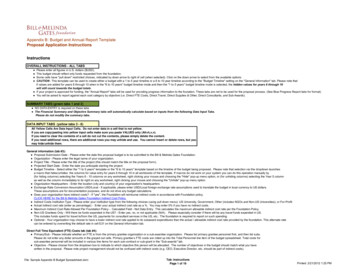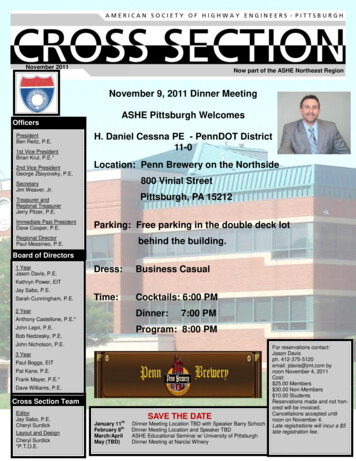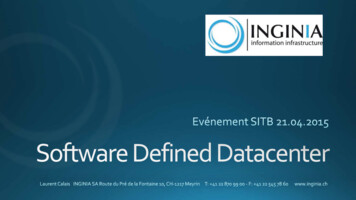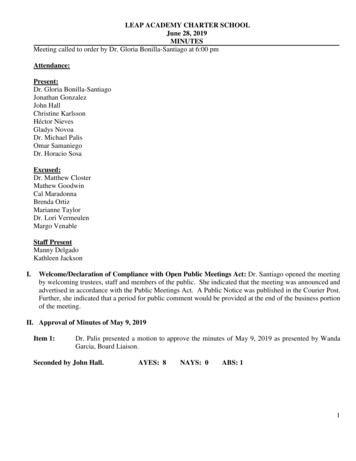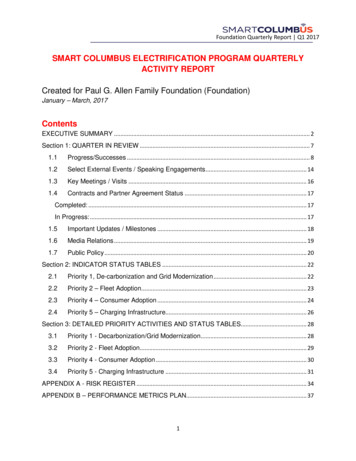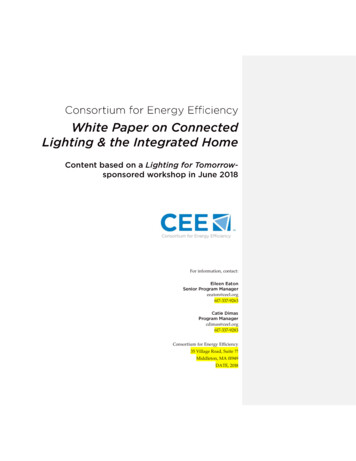
Transcription
For information, 617-337-9283Consortium for Energy Efficiency35 Village Road, Suite ?Middleton, MA 01949DATE, 2018
TBD, 2018Version 1.0This document may not be reproduced, disseminated, published, or transferred in any form or byany means, except with the prior written permission of CEE or as specifically provided below.CEE grants its members and participants permission to use the material for their own use inimplementing or administering the specific CEE Initiative to which the material relates on theunderstanding that: (a) CEE copyright notice will appear on all copies; (b) no modifications to thematerial will be made; (c) you will not claim ownership or rights in the material; (d) the materialwill not be published, reproduced, transmitted, stored, sold, or distributed for profit, including inany advertisement or commercial publication; (e) the materials will not be copied or posted onany Internet site, server, or computer network without express consent by CEE; and (f) theforegoing limitations have been communicated to all persons who obtain access to or use of thematerials as the result of your access and use thereof.CEE does not make, sell, or distribute any products or services, other than CEE membershipservices, and CEE does not play any implementation role in the programs offered and operatedby or on behalf of its members. The accuracy of member program information and ofmanufacturer product information discussed or compiled in this site is the sole responsibility ofthe organization furnishing such information to CEE, and CEE is not responsible for anyinaccuracies or misrepresentations that may appear therein.CEE does not itself test or cause to be tested any equipment or technology for merchantability,fitness for purpose, product safety, or energy efficiency and makes no claim with respect thereto.The references and descriptions of products or services within the site are provided "As Is"without any warranty of any kind, express or implied. CEE is not liable for any damages,including consequential damages, of any kind that may result to the user from the use of the site,or any of the product or services described therein.
The Consortium for Energy Efficiency (CEE) is a nonprofit organization through which efficiencyprogram administrator members work to promote energy efficient products, technologies, andservices. Collectively, CEE members direct nearly 80 percent of customer-funded demand sideexpenditures in the United States and Canada, using initiatives that accelerate the developmentof energy efficient products and services. CEE increases the effectiveness of its memberorganizations by enhancing communication among program administrators and harmonizingapproaches across geographies to advance energy efficiency for the public benefit. Memberswork together at CEE to create voluntary specifications and associated qualifying products listsfor more efficient products and systems that they can promote locally through efficiencyprograms.The role of CEE is to establish the important performance factors related to energy efficiency thatare commonly shared across the United States and Canada and to encourage binationalcoordination of efficiency programs to realize additional energy savings opportunities. The CEEfocus, as embodied in binational voluntary CEE market initiatives, is to stimulate marketdevelopment, competition, and investment to create new energy-related value for ratepayers,contributing stakeholders, and society as a whole. A key strategy is to seize on the convergence ofrevolutionary advancements in technology, information management, and communicationcapabilities, specify conventions for major interdependent energy ecosystems, and encourageindependent and voluntary market action to realize unprecedented value.CEE works closely with other stakeholders active in the lighting and connected product spaces,including the United States Environmental Protection Agency and the ENERGY STAR program,United States Department of Energy and its national labs, California Energy Commission, theNational Electrical Manufacturers Association (NEMA), the American Lighting Association(ALA), the Air-Conditioning, Heating, and Refrigeration Institute (AHRI), and the Electric PowerResearch Institute (EPRI). By collaborating with these other entities, CEE is able to create a singleplatform for program administrators and industry that leverages the best available resources.
CEE would like to thank the following individuals for their involvement in developing theagenda for the Lighting for Tomorrow-sponsored Connected Lighting Workshop, presenting andparticipating at the workshop, and reviewing the whitepaper.Terry McGowan, American LightingAssociationPeter Brown, on behalf of CommonwealthEdisonJeremy Snyder, Lighting Research CenterPekka Hakkarainen, Lutron ElectronicsEric Fournier, MaxLiteChris Primous, MaxLiteAndrew DeBlasio, Commonwealth EdisonErin Sullivan, Natural Resources CanadaJim Fay, Commonwealth EdisonChris Wolgamott, Northwest EnergyPeter Romaniello, Conceptual LightingRon Zimmer, Continental AutomatedBuildings Association (CABA)Efficiency AllianceRuth Taylor, Pacific Northwest NationalLaboratoryJeff LeBrun, DTE EnergyEmmett Romine, PowerleyThac Nguyen, DTE EnergyDave Simoni, Progress LightingTara Bolen, Duke EnergyMary Medeiros McEnroe, Silicon ValleyCandyce Marsh, Duke EnergyPowerAmy Sadler, Duke EnergyKelly Hugunin, Sprosty NetworksBob Smith, Eaton LightingRick Rommel, Sprosty NetworksJenna Pugliese, Efficiency VermontTeren Abear, Southern California EdisonLinda Longo, enLIGHTenment MagazineRichard Greenburg, Southern CaliforniaMichael Estrin, Estrin Zirkman SalesEdisonLisa McLeer, GE LightingDave Edwards, ULJeff Patton, GE LightingBrian Ferriol, ULLaurie Gross, Gross Electric, Inc.Adam Lilien, ULSteve Parker, Independent ConsultantTodd Straka, ULJeff Dross, Kichler LightingKeith Cronin, Wisconsin Focus on EnergyTim Stumm, Lights Fantastic DallasCommented [CU1]: FOR TERRY: Linda indicated he is nolonger with Lights Fantastic but his LinkedIn isn’t updatedpast that?
TBD
In 2018, Lighting for Tomorrow (LFT) tapped into the relationships with lighting stakeholders builtover the past 16 years and gathered experts from across the lighting, smart home, and demandside management program industries to imagine and discuss the future of residential lighting.Through an interactive workshop, participants explored the potential of new technologies,product capabilities, and program strategies to overcome market barriers and deliver benefit toconsumers and the grid.The residential lighting market is experiencing unparalleled disruption caused by companyacquisitions and entrance of new market players related first to solid-state lighting and nowconnected capabilities. During this time of transition, there are varying perspectives regardingpossible direction for connected residential lighting market. However, one thing is clear: thismarket is growing, the estimated revenue for connected residential lighting is expected to rise to 4.5 billion by 20211, and it will be increasingly merging into the integrated home segment. Thereare opportunities to encourage this growth in a way that supports the needs of consumers andprogram hting-controls-reached-8-billionin-2017
While connected lightingpresents potential energysavings opportunities, theprimary value to CEEmembers lies in its abilityto serve a strategy forincreased customerengagement and as a partof the customer journey toan integrated home2,which can deliver benefitsfrom consumer behaviorchange, improvedmeasurement andverification of energysavings, and load management. Some program administrators contend that connected lightingmay serve organizational objectives in addition to energy savings, including demand response,carbon reduction, increased program participation, and additional revenue streams. Overarchingopportunities are an enriched engagement with customers and the ability to support a positiveconsumer experience with connected technologies.Workshop participants discussed the barriers that would most significantlyinhibit uptake of connected lighting and concluded that focusing on theconsumer experience is critical for successful market adoption. The variationamong platforms and communication protocols currently in the market, asA few platformsand protocols usedby connectedlamps and controlswell as the limitations or benefits of each, creates considerable confusion forconsumers. Lighting manufacturers are seeking ways to simplify use forconsumers as well as provide new value or services through cross-industrypartnerships. There are currently a few lighting products in the market that donot rely on a bridge or hub to connect with products from other manufacturersAmazon EchoApple HomeKitGoogle HomeIFTTTSmart ThingsWink Hubor those operating on other platforms, and more companies are exploring thisoption. The list on the right captures the most common platforms andprotocols that manufacturers in this market have adopted. While the myriad platforms andprotocols underscore the lack of widespread interoperability in the market, knowing the2CEE members have landed on the term “integrated home” to describe a framework for the converging landscape ofconnected products within the whole house context. The integrated home is grid-interactive and efficient; it encompassesconnected technologies and communicating capabilities that have the potential to optimize the performance of the homethrough individual products and systems and drive improved energy management.
prominence of the different interfaces helps manufacturers work toward developing platformagnostic devices. It is expected that eventually interoperability will become more commonplace,but how and which platforms arise as mainstream is yet to be seen.Based on the workshop discussion, participants identified the top three barriers to realizing thebenefits of connected lighting as: Participants recognized that the top barriers identified are not exclusive to lighting and areapplicable to all connected devices in a home. There are many new connected home solutionsavailable, but they all require interoperability, reliability, and simplicity.There was also consensus that lighting is a good place to focus. Given high consumer interest,low price point, mass market appeal of connected lighting, as well as its presence throughouta home, lighting is an ideal candidate to support a consumer journey to a fully integratedhome.Lighting for Tomorrow presents a unique market intervention strategy to increase the adoptionof residential connected lighting products in the US and Canada. It offers the opportunity tobuild upon the existing relationships between program administrators, lightingmanufacturers, and showrooms to enact market change. Lighting for Tomorrow also presentsprogram administrators with the unique opportunity to influence the connected devices thatmanufacturers are bringing to market and encourage those products with the performanceattributes programs wish to promote. This is specifically achieved through selection of thecompetition categories and evaluation criteria.Based on the suggestions received from the workshop, sponsors support leveraging theLighting for Tomorrow competition model with an expanded scope in 2019. They areenvisioning a rebranding to “Lighting & Homes for Tomorrow”, which would evolve andadd competition categories over time.
Currently administered by the American Lighting Association (ALA)3, sponsoring members ofthe Consortium for Energy Efficiency (CEE)4, and UL5, the annual Lighting for Tomorrow (LFT)competition was created in 2002 to overcome the greatest barrier to the adoption of residentialenergy efficient lighting: the lack of decorative fluorescent fixture. The competition serves as anexcellent platform to recognize the best decorative, energy efficient lighting fixtures in themarket. Since its inception, LFT has encouraged manufacturers to develop well designed, energyefficient lighting products with a specific goal of increasing the availability and market adoptionof ENERGY STAR certified residential lighting products. Lighting for Tomorrow providesresidential lighting manufacturers the opportunity to push the industry forward by introducinghigh quality and innovative designs, contribute to the greater energy efficiency movement, andgain exposure for their brands and products among industry leaders and consumers alike.Through recognizing exceptional new products, LFT seeks to meet consumer expectations andleap over market barriers that inhibit the adoption and use of energy efficient residential lighting3ALA is the only trade association representing residential lighting manufacturers, showrooms, distributors,manufacturer representatives, component manufacturers and industry-related companies. ALA members, totaling morethan 1,200 in the United States, Canada and the Caribbean, are dedicated to providing the public with quality residentiallighting.4CEE is a consortium of energy efficiency program administrators from the United States and Canada. Members work tounify program approaches across jurisdictions to increase the success of efficiency in markets. By joining forces at CEE,individual electric and gas efficiency programs are able to partner not only with each other, but also with other industries,trade associations, and government agencies. Working together, administrators leverage the effect of their ratepayerfunding, exchange information on successful practices and, by doing so, achieve greater energy efficiency for the publicgood (see the CEE Annual Report, 2017 Annual Industry Report, and Members Page for more details).5UL is a global independent safety science company with more than a century of expertise innovating safety solutionsfrom the public adoption of electricity to new breakthroughs in sustainability, renewable energy and nanotechnology.Dedicated to promoting safe living and working environments, UL helps safeguard people, products and places inimportant ways, facilitating trade and providing peace of mind. UL provides testing and certification services to industrystandards including UL, ANSI, IEC, NEMA, FCC, and IESNA. Additionally, UL is a leading provider of PhotometricPerformance and EMC testing in support of well-known lighting programs such as ENERGY STAR , Lighting Facts, andDesign Lights Consortium.
products.From 2002 through 2017, the sponsors of this unique and longstanding industry partnershipconsidered the market barriers that inhibited the adoption and use of energy efficient residentiallighting. They worked together to create product categories and criteria that considered evolvinglighting technology and strived to help support its successful integration into lamps, retrofit kits,and fixtures, to ensure that these products would meet consumer needs. The following is anexample of how Lighting for Tomorrow encouraged the efficiency and quality aspects of a newproduct type and supported its inclusion in the ENERGY STAR Program.The emergence of the “smart” home has brought exciting new features and capabilities to marketalong with challenges for lighting and whole house interoperability. Both customers and utilitiesare moving into a future of energy savings from a systems approach to dimming, integration, andconnectivity with other residential products. Beyond energy savings, there are potentialopportunities related to comfort, health, convenience and security. Lighting for Tomorrowcontinued to monitor developments in the connected lighting space, and to consider the types ofproduct criteria that would help yield the most benefit to consumers and efficiency programsalike.In 2017, Lighting for Tomorrow accepted connected lighting entries as part of a standalone categoryfor lamps, fixtures, controls, and broader systems. Entrants were asked to provide data aboutproduct or system attributes and functionality and were evaluated against criteria relating to easeof installation, setup, and use; ease of continued use; interoperability; user interface; value andsalability; application efficiency (e.g., standby power consumption); replaceable component andfield serviceability; and innovation in engineering and design. While the level of participationwas relatively successful for a brand-new category (three percent of submissions were connected,
and included luminaires, wireless controls, and other product types), the diverse experts on thejudging panel felt that entries overall were “holding back” and that few were meeting consumerexpectations across the board. Examples included an inability to interoperate with other productsin the home, complicated setup and programming, and a perceived decrease in some aspects ofoverall lighting quality when compared to standard products.Following the 2017 competition, sponsors deliberated and determined that one of the biggestremaining opportunities for residential lighting and LFT would be to further explore the energysavings and customer engagement prospects of connected lighting technologies within thecontext of a smart/connected /integrated home. Lighting often represents a consumer’s first forayinto creating an integrated home and may serve a central device in these homes as newfunctionalities, such as sensing, processing and networking are added. Controllable and tunablelighting increase the odds that a consumer will be satisfied with the lighting quality of theirefficient purchase and may remove the need to educate about color and lumens to support apositive consumer experience and ultimately market transformation.Heading into 2018, the Lighting for Tomorrow sponsors organized an in-person workshop in lieu ofthe traditional competition; the workshop focused on reassessing market needs and allowed avariety of stakeholders to better examine how, as an industry, to continue transforming thecurrent program and market climate.According to a 2018 survey conducted by the Lighting Research Center, “we may be experiencingthe largest, most fundamentalchange the lighting industryhas seen in our lifetime.”6While the current Lighting forTomorrow sponsors and manyCEE members more broadlybelieve there are still existingopportunities to transformthe residential lightingmarket (a significant amountof inefficient lighting is stillbeing sold, for example),there were other factorsprompting the decision toconsider an alternative to thetraditional competition. Due6https://www.lrc.rpi.edu/resources/newsroom/pr story.asp?id 413#.W60UtmhKjcs
to increased federal minimum efficiency standards, program administrators are seeing the costeffectiveness of residential lighting programs decline and funds available to support these effortsare being reduced. It was fortuitous that the timing of impending federal changes and theemergence of connected lighting happened to align with the project reaching its fifteenth year. Itpresented a perfect opportunity to strategically consider the role of Lighting for Tomorrow goingforward; 2018 was intended to be a transition year in which Lighting for Tomorrow partners wouldassess the future of the competition and whether that model for market transformation is stillrelevant and appropriate. Sponsors sought to invite experts from across the lighting, connectedhome, and utility program spheres to imagine and discuss the future of residential lighting.An interactive workshop was determined to be the optimal channel for program administratorsto come together with thought leaders from the lighting and connected home industries todiscuss future opportunities for collaboration in ensuring a positive residential customerexperience – not only with efficient lighting technologies, but also with emerging functionalityenabled by connectivity. The primary intent was for workshop participants to explore howvarious stakeholders, and in turn the Lighting for Tomorrow platform, can harness recentdevelopments in the lighting market to further increase energy savings and potentially offer newvalue streams such as energy management or non-energy benefits.The emergence of the smart/connected/integrated home brings exciting new features andcapabilities, including new challenges for lighting and whole house interoperability. Bothcustomers and utilities are moving into a future with a systems-based approach to dimming,integration, and connectivity with other residential products.Through the interactive Lighting for Tomorrow workshop, participants explored the potential ofnew technologies, product capabilities, and program strategies to overcome market barriers anddeliver benefit to consumers and the grid. The objectives of the workshop effort were to: Allow invited lighting manufacturers, retailers, researchers, and relevant connected homestakeholders to collaborate on the future of quality residential lighting and the integrated home.Explore lighting technology and residential program trends and expected developments,including the possibility of additional energy savings or even load management opportunities.Explore what new functions or services beyond lighting, that lighting fixtures, lamps, andswitches may provide consumers in the future, such as sensing, processing and networking.Consider the characteristics of connected lighting products or systems that would help yield themost benefit to consumers, industry, and DSM programs alike, including non-energy impacts.Discuss how various stakeholders might promote or integrate connected lighting in new ways.Determine the potential role of LFT going forward, including if and how a competition modelstructured around these concepts might be applied in 2019.The workshop enabled program administrators and industry to take stock of the future oflighting from high-level industry, consumer, and DSM program perspectives. Sponsors believeda visionary conversation could be very valuable for helping all stakeholders consider a collective
vision for lighting and the connected home. The resulting workshop agenda sought to addressthe following questions: What remains to be done to support the adoption of energy efficient technology in the residentiallighting market?What new value and opportunities will exist due to the emergence of connected lighting? (Thisincludes value for consumers, program administrators, manufacturers, and retailers)What are the barriers to realizing these opportunities? What can efficiency programs and industrypartners accomplish by working together binationally to overcome these barriers?How can the LFT platform be leveraged to support these collective efforts?This whitepaper documents the workshop discussions and key takeaways, including criticalperspectives on the connected lighting market and identification of critical market or technologygaps for further research or collaboration. The defining characteristics of connected lighting andintegrated homes in the context of this work are included below, as well as additionalinformation about the history of Lighting for Tomorrow and the nexus of the workshop.As part of a common set of guiding principles for two-way communicating technology, CEEmembers use the term “connected” to describe equipment that is engineered to send and receiveinformation, including between other equipment and systems, to enable new value for customersand the grid, including the potential to unlock new savings opportunities that will complementtraditional efficiency measures. There is currently no standard industry definition of connectedlighting, and the scope includes devices beyond traditional replacement lamps and fixtures (suchas lighting controls, systems, or system components). For the purposes of the white paper, pleasereference the following definitions: 7: A controllable and intelligent solid-state lighting source capable of using,or consuming data, one or more network interfaces, and one or more sensors (i.e. dataproducers).7: A luminaire or retrofit which includes elements or instructions (hardwareand software or firmware) required to enable communication in response to consumer-authorizedenergy or performance related commands and complies with all requirements for connected in thespecification. These elements may be resident inside or outside of the base luminaire or retrofit. 8: A connected lamp includes elements (hardware and software or firmware) orinstructions required to enable communication in response to consumer-authorized energy orDOE SSL Program8ENERGYSTAR Connected Luminaire (Version 2.1).Source
performance related commands and complies with all requirements for connected lamps in thespecification. These elements may reside inside or outside of the base lamp.9Commented [CU2]: Change info graphic to remove“connected” from before lightingCEE members have landed on the term “integrated home” to describe a framework for theconverging landscape of connected products within the whole house context. The integratedhome is grid-interactive and efficient. It encompasses connected technologies and communicatingcapabilities that have the potential to optimize the performance of the home through individualproducts and systems and drive improved energy management. Such improved energymanagement may come through a combination of energy efficiency, load management (includingdemand response), and consumer behavior. In practical terms, the integrated home is acomprehensive portfolio of residential initiatives that can be bundled together to deliverefficiency, grid, program, and customer benefits beyond those that can be achieved individually.The suite of product specifications that include connected criteria delivers a consistent valuepromise that is contingent upon individual end measures working together effectively to enablethese added benefits. The integrated home therefore relies on the interaction, interoperability,and interactive effects between chosen products and systems. It may also leverage interactionswith the user, through selecting predetermined preferences or settings, learning algorithms, orprompting a specific consumer behavior.9ENERGYSTAR Connected Lamp (Version 2.0).
Per current CEE member consensus, the integrated home Includes a suite of energy efficient (based on laboratory ratings) products with sensing and twoway communication functionality to potentially monitor, track, control, or analyze energy use.They may provide additional energy efficiency benefits by enabling operation and managementoptimizationEncompasses any services, hardware, or software that serves to optimize overall energy use of ahome. This may be achieved at the individual product or system level, holistically at the houselevel, or broader at the site or community levelIs inclusive of all fuel typesIs capable of enabling automated demand response (DR)10 and behavioral DR11Is mindful of additional grid and societal benefits such as incorporation of energy storage anddistributed energy resources, including the integration of renewablesSecurely provides data exchange – directly or through advanced metering infrastructure – tosupporto Utilities – evaluation and verification; enhanced customer engagement12, targeting, andsatisfactiono Customers – enhanced energy management, feedback regarding behavior-based savings,positive experience with connected technologies (including fault diagnostics) and utilityrelationshipHas implications for customer non-energy impacts (amenities unrelated to grid benefit), such ashealth, comfort, safety, and securityGives customers ultimate control of their products and associated dataData associated with how an integrated home is operating can provide value for multiplestakeholders and intended purposes. Information that is remotely accessible by both the DSMprogram administrator and its customers can enhances channels of communication that facilitateactionable energy management. The CEE residential connected product specifications will beginto include the core minimum datasets necessary to support customer engagement and energymanagement platforms. These requirements are central to enhancing programs’ ability to meetevaluation goals. They are also key components for demonstrating value to relevant marketactors such as the real estate industry, financing entities, appraisal groups, health and safetyadvocates, and home improvement allies.101112ADR involves technologies that automatically reduce energy usage during demand response events and may include automated signaling from an energy supplier thatallows connectivity to the customer’s control systems.BDR involves providing customers with pre/post-event communications and social comparisons specifically aimed at reducing usage on peak demand (event) days.Customer engagement refers to any mechanisms designed to augment the relationship between ratepayer and program administrator. It encapsulates strategies orapproaches that increase the availability of or access to energy efficiency program offerings. The intended customer investment is achieved through interventions aimed atinfluencing the customer spectrum of awareness, interest, desire, or action.
CEE has long had a careful and trusted process in which specifications are: designed throughbinational, consensus-based deliberations, vetted with manufacturers, and ultimately supportedby collective action of its members. The various CEE Committees are increasingly mindful of howconnected capabilities impact energy efficiency, grid demand, and consumer experience. Thetable below details current CEE work efforts aimed at advancing the integrated home for thebenefit of consumers and a better-balanced grid.Individual CEE Initiatives are continuing to develop optional connected criteria thatmembers can leverage in
Jeff LeBrun, DTE Energy Thac Nguyen, DTE Energy Tara Bolen, Duke Energy Candyce Marsh, Duke Energy Amy Sadler, Duke Energy Bob Smith, Eaton Lighting Jenna Pugliese, Efficiency Vermont Linda Longo, enLIGHTenment Magazine Michael Estrin, Estrin Zirkman Sales Lisa McLeer, GE Lighting Jeff Patton, GE Lighting Laurie Gross, Gross Electric, Inc.



